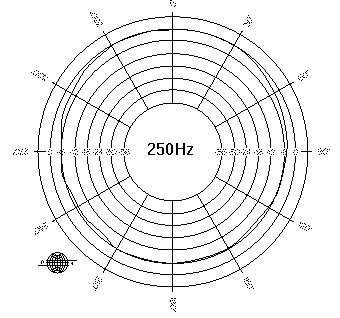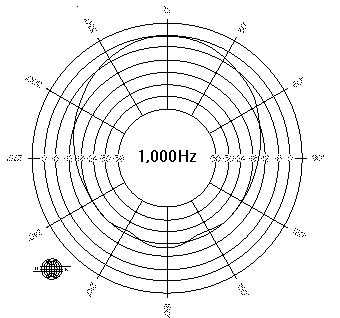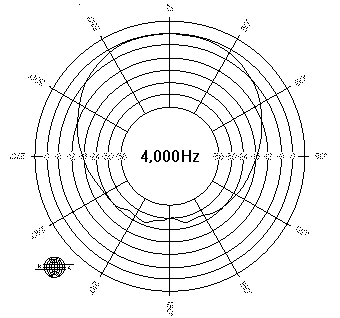
Main Page
Design Staff
Design Services
Project List
Audio Demos
Useful Calculators
All over the map
Site Map
Contact Us
Related Pages
A/V Systems
Cluster Design for Intelligibility
Intelligibility Calculator
Sound System Design
Speech Intelligibility
Video Conference Facilities
|
 |
Loudspeaker Facts:
Directivity as a Design Issue
Part 1
We've split this article into three pages to keep the file size manageable. There are a minimum number of small graphics on each page. You'll find the links to the next pages on the bottom of each one, and the links to previous pages on the top of each page.
"Throw" away lines
Many people in the sound system contracting industry believe that the "throw" or capability of a speaker to project sound at a distance is all that has to be considered when designing a loudspeaker system. A "short throw" speaker system is used to cover the areas nearer to the loudspeaker and a "long throw" speaker system is used to cover the the areas furthest away from the loudspeaker. For example a balcony in a theatre or church is a job for a "long throw" horn or system.
This concept works fine in systems with limited bandwidth, typical of a PA or speech system in an outdoor grandstand, or in touring rigs where the massive size of the speaker system is the dominant factor. Where the concept fails is a single loudspeaker, or a small cluster of loudspeakers in a facility where you need to have the same frequency response and sound quality in all the seats both near and far. In a large scale sound system that is required to deliver music to all the seats, like a large church, or auditorium, the issues of maintaining a balanced sound through the seats makes this much more complicated than picking long and short throw speakers.
Loudspeaker Directivity
We have discussed directivity elsewhere in general terms. In a loudspeaker system, the directivity is an indication of how directional the loudspeaker is, or to look at it another way, how effective the speaker is at taking the sound it produces and sending it in one particular direction instead of all directions. A loudspeaker that is a high directivity device is commonly called a "long throw" device. A speaker with low directivity is a "short throw" device. This sounds pretty straightforward, but as always there's a catch when dealing with the laws of physics. Because the wavelengths of sound have such a wide range of physical size; from 1/2inch (1cm) to 55 feet (18m), it is not possible for a loudspeaker to have the same directivity (or "throw") at all frequencies.
Bass frequencies have very long wavelengths which make it difficult to control the direction they travel. For a loudspeaker to have moderate control of directivity at 40Hz would require a physical size greater than 18 feet (6m) square. To maintain any directional control at 100Hz requires a size in excess of 6 feet (2m) square. Even at 500Hz, a loudspeaker has to be over 3 feet (1m) square. Up in the rarified atmosphere of higher frequencies, say 2,000Hz+, the speaker can be as small as 1 foot (30cm) square. At ultra-high frequencies, above 8,000Hz, a super tweeter is difficult to build without it having too much directional control, because at any physical size you can build the device it tends to become very directional through its operating band.
View an animated directivity balloon of a real full range packaged array type loudspeaker, measured on one octave centres. Note how the coverage pattern changes, narrowing from near omnidirectional at 125Hz to a much narrower pattern at 8kHz. (65kB image)
Chromatic Aberration
To use a light analogy, what this amounts to is a form of chromatic aberration. Imagine a loudspeaker system, any one will do, as long as you and one other person could pick it up and carry it. That limits the size to approximately 48 inches (1200mm) high, 24-36 inches (600-1000mm) wide and 24 inches (600mm) deep. Now assume that this loudspeaker is a full range system, capable of reproducing the full spectrum of sound from 20Hz to 20,000Hz. Further assume that it is very high quality system that is ruler flat in frequency response when you are listening on-axis right in front of it, and it still sounds pretty good when you listen off-axis. Now you and the other person can carry it outside so the room does not affect what we are hearing, and we'll listen to it again.
Outdoors it still sounds good when you are standing 6 feet (2m) in front of it, but as you move to the side 3-4 feet you may notice that the sound character changes, there's still lots of bass, but some of the sparkly high end is gone, and the voices sound a bit odd like there's something missing. Now move right around to the side, at right angles to the speaker axis, and you'll find the high end and much of the midrange gone. Now walk around behind the back of the box, and what do you hear? You hear the bass, and not much else.
Where the bass wavelengths are very long (55 feet to 11 feet for 20Hz to 100Hz) the sound "wraps" or diffracts around the box because the box dimensions are too small to make these wavelengths directional. In the region between 100Hz and 1000Hz the box is increasingly more capable of making the sounds directional so the coverage of the box can become narrower. Above 1000Hz, most loudspeakers are of a size that the device by itself can control the directivity of the sound coming from it (not always well controlled mind you). Above 2,000Hz most medium format high frequency horns are pretty effective at pointing sound where you and the manufacturer will expect it to go. By the time you're up to 8,000Hz and beyond, in the land of super tweeters, the opposite problem is apparent, the coverage is usually a small fraction of what it is at 2,000Hz, and it becomes difficult to keep the coverage from collapsing into a narrow beam.
If you walk around to the front of the box and begin walking away from the box to perhaps ten times the original listening distance (60 feet or 20m), what do you hear? Has the box changed in frequency balance? What has gone missing? The bass and the extreme high frequencies are both lower in level (now don't confuse this phenomenon with boom cars and bass that can be heard blocks away, that is a different scenario entirely resulting from way too much bass to start with). The bass has dropped in level because you've lost as much or more sound energy out to the sides and around back of the box as you would have received by standing in front of it. The very high frequency information has likely been lost through air absorption (assuming we're now back 60 feet or more). What is left is likely 100Hz to 6kHz, the frequency band where the box has some measure of directivity. What do you do? You try to turn it up so you can hear the bass and highs again, but it gets louder and doesn't sound better way out there. As you walk back to turn it up again, you get within 10 feet of the box and you notice that the high frequencies are loud enough to rip your ears off (air absorption helps attenuate HF distortion products too), and that the bass behind the box where the amplifier is located is almost loud enough to make you ill. Instead of just turning the volume up you can put the typical "smile" EQ curve into the system to boost the bass and highs so it sounds better way out front, but now it sounds really awful up close. Where the box has some directivity it will direct sound forward along the speaker axis better than it can at low frequencies where it "spills" the bass off to the sides. This isn't as obvious indoors because the room walls and room reverberation confuse the issue of what is actually happening.
Equalize?
You can't use an equalizer to correct for frequency response variations caused by variations in directivity. You can increase or decrease the overall output of the speaker system at specific frequencies with an equalizer, but you can't change the frequency response in specific directions. If the bass was just right in front and too loud behind the box, then you can't turn it down behind the box without turning it down in front of the box too. If the mids were too hot on-axis but sounded pretty good everywhere else, you can't turn it down on-axis without making it sound wooly or muffled everywhere else. If it sounds good out in front but gets muffled as you walk underneath it, you can't equalize it to fix the area underneath it without making it far too bright out in front. The problem is that the loudspeaker has a different frequency response in every direction. This is why that polar response graph in the spec sheet is so important, more people end up listening to a speaker off-axis than on-axis.
Moving back indoors
"Very nice experiment Mr. Science," you say, but I'm not listening outdoors, I'm in a church or theatre and I want to hang these boxes over the stage or the altar, and get sound to the balcony 75 feet (23m) away. Thinking back to what we have discovered so far, you will recollect that a speaker has no significant directivity at the bass frequencies, it is almost as loud behind as in front, or below the speaker. As we move up in frequency we have more directional control available. In the frequency range between 250-1000Hz the coverage pattern will typically go through large variations in a single loudspeaker. If you happen to have more than one, the variations are extreme and hard to predict. Above 1000Hz the speaker starts to behave more like one would hope and expect, you can point it and expect most of the the sound to get there. Have a look at these polar patterns of a popular loudspeaker at 250Hz, 1,000 Hz and 4,000Hz. Each concentric ring represents 6dB in level change.



Notice that the 250Hz plot is almost impossible to distinguish from the coordinates of the polar map, it is almost omnidirectional, it is 6dB quieter behind than in front. The 1,000Hz coverage is narrower, but this is a small box with a 12" loudspeaker so there is still fairly wide coverage, and the level to the side of the box is 15dB lower than directly on-axis. At 4,000Hz, this box has become narrower yet, and the level to the side is 18dB lower than directly on-axis. Let's look at what these variations mean for your balcony shot.
Next page - The Light Analogy
Return to top

|


